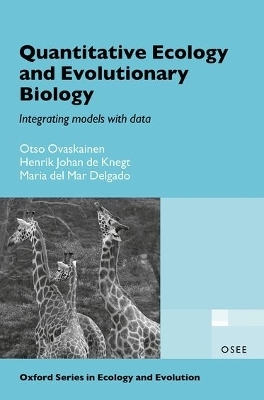
Quantitative Ecology and Evolutionary Biology
Oxford University Press (Verlag)
978-0-19-871487-3 (ISBN)
This novel, interdisciplinary text achieves an integration of empirical data and theory with the aid of mathematical models and statistical methods. The emphasis throughout is on spatial ecology and evolution, especially on the interplay between environmental heterogeneity and biological processes. The book provides a coherent theme by interlinking the modelling approaches used for different subfields of spatial ecology: movement ecology, population ecology, community ecology, and genetics and evolutionary ecology (each being represented by a separate chapter). Each chapter starts by describing the concept of each modelling approach in its biological context, goes on to present the relevant mathematical models and statistical methods, and ends with a discussion of the benefits and limitations of each approach. The concepts and techniques discussed throughout the book are illustrated throughout with the help of empirical examples.
This is an advanced text suitable for any biologist interested in the integration of empirical data and theory in spatial ecology/evolution through the use of quantitative/statistical methods and mathematical models. The book will also be of relevance and use as a textbook for graduate-level courses in spatial ecology, ecological modelling, theoretical ecology, and statistical ecology.
Otso Ovaskainen obtained his PhD in mathematics in 1998 at the Helsinki University of Technology. To combine his mathematical training with his interest in ecology, he did his postdoctoral training with Professor Ilkka Hanski in Helsinki University and with Professor Bryan Grenfell in Cambridge University. He became a research fellow funded by the Academy of Finland in 2003, at which time he founded the Mathematical Biology Group, which is part of Ilkka Hanski's Metapopulation Research Centre. He became a professor in Helsinki University in 2009, and a visiting professor in Trondheim University in 2014. He is broadly interested in mathematical and statistical approaches in ecology and evolutionary biology. Henrik de Knegt obtained his PhD in ecology in 2010 at Wageningen University (the Netherlands), after which he moved to Finland as a postdoctoral researcher at the University of Helsinki. He is broadly interested in spatial ecology, especially the small-scale mechanisms behind the movement and habitat selection of organisms. This is because the movement process couples organisms to their spatial-temporal environment, and is vital to coupling individual-level behaviour to population-level dynamics. He recently moved back to the Netherlands where his work at Wageningen University aims at contributing to the prevention of rhino poaching, through the development of a response system that highlights where and when poaching is taking place, based on anomalies in animal movement patterns that might signal poaching-induced disturbances. Maria del Mar Delgado did her degree in Biology at the University of Seville (Spain), and then a PhD in ecology at Doñana Biological Station (CSIC, Spain). She then moved to Finland where she has spent her last seven years as a postdoctoral researcher. She is interested in a wide array of issues within behavioural and evolutionary ecology, biodiversity and conservation biology. The main goal of her scientific trajectory is to carry out multidisciplinary, synthetic ecological and evolutionary research with a strong collaborative basis. Ecology and evolution are essentially trans-disciplinary areas, and thus she has always been interested in combining experimental, theoretical, and observational approaches. The main focus of her research is on gaining an integrated understanding of the structure and dynamics of natural populations and communities by combining rigorous statistical analyses with long-term monitoring data.
1: Approaches to ecological modelling
2: Movement ecology
3: Population ecology
4: Community ecology
5: Genetics and evolutionary ecology
Appendix A: Mathematical methods
Appendix B: Statistical methods
| Erscheinungsdatum | 12.05.2016 |
|---|---|
| Reihe/Serie | Oxford Series in Ecology and Evolution |
| Verlagsort | Oxford |
| Sprache | englisch |
| Maße | 166 x 233 mm |
| Gewicht | 524 g |
| Themenwelt | Mathematik / Informatik ► Mathematik ► Angewandte Mathematik |
| Naturwissenschaften ► Biologie ► Evolution | |
| Naturwissenschaften ► Biologie ► Ökologie / Naturschutz | |
| Naturwissenschaften ► Biologie ► Zoologie | |
| ISBN-10 | 0-19-871487-4 / 0198714874 |
| ISBN-13 | 978-0-19-871487-3 / 9780198714873 |
| Zustand | Neuware |
| Haben Sie eine Frage zum Produkt? |
aus dem Bereich


